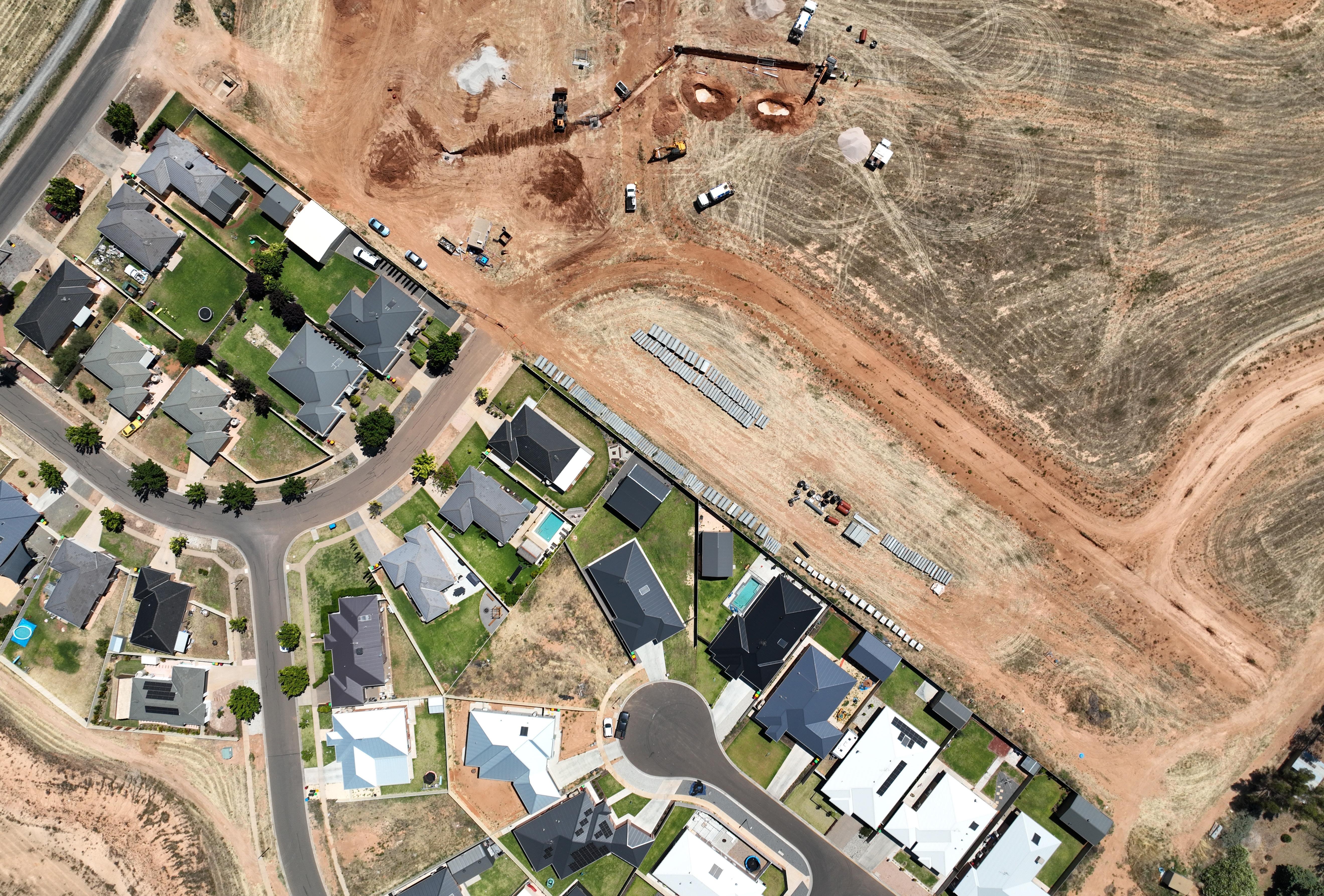Victorian Resale Feature
JUNE 2025 VS. DECEMBER 2024


JUNE 2025 VS. DECEMBER 2024

The secondary land market has contracted for a second consecutive six-month period, falling well below last year’s highs. In June 2025, resale listings across Melbourne and Greater Geelong totalled 1,616, which is less than half of the 3,365 recorded at the June 2024 peak.
This drop was driven by the mix of improved sales, partly fuelled by the interest rate cuts in February and May, and some stock being withdrawn from the market.
Secondary Land Market Stock Count - Total Melbourne and Greater Geelong
Resale listings now make up just 21% of total land stock (1,616 out of 5,917 listings), compared to 39% at the mid-2024 peak. This easing has reduced the risk of resale stock undercutting demand for new projects through lower prices, immediate titling, and often larger block sizes. Even so, volumes remain high compared to the peak HomeBuilder period of FY21-22.
Secondary Land Market Size vs. All Land Stock
Source: RPM Research, Data & Insights
Resale activity in Melbourne’s growth corridors has contracted sharply over the past six months, reversing the record highs seen a year earlier. In almost every corridor, the secondary land market has now shrunk to its smallest size in nearly three years.
The steepest corrections have been in the Western (Melton, Moorabool, and Wyndham) and Greater Geelong corridors. In both markets, resale listings have fallen by roughly half since the start of the year.
Geelong, in particular, has seen renewed buyer activity significantly reducing stock in coastal growth area.
Improving buyer confidence is evident in both reduced resale listings and pricing trends.
Across Melbourne’s growth corridors, the average resale lot price rose 2% in the past six months to $446,500, while average lot size increased 4% to just under 500sqm. Overall, the price per square metre lifted only 1%, with the South East and Geelong corridors both recording 2% declines.
Larger block averages are being skewed by higher priced outliers that remain unsold, as many buyers are unable to stretch budgets to these levels, leaving them on the market longer. These outliers lift the average size, even as most buyers remain focused on smaller, more affordable lots.
Price sensitivity remains a strong factor in the resale market. Resale supply volumes must remain tight to support sales and prevent further discounting.
Resale Market Price And Sizing Movement
Larger, more established estates often have more resale listings as they progress through their development cycle and the primary land market matures.
in
a masterplanned community of over 11,000 lots, has the highest share of resale stock currently on the market.
Stockland holds the largest resale market share, due by its portfolio of large, well-established estates such as Mt Atkinson and Cloverton. Moremac, Newland Developments, and Dennis Family Corporation also have a notable volume of resale lots across their projects.
Resale lots are becoming increasingly cost effective on a per square metre basis compared to retail stock, with the gap widening over the past six months. This is driven by two key factors:
1. A steady turnover of resale listings, which keeps downward pressure on prices as vendors compete to sell.
2. More affordable lots that lift the price per square metre rate through higher pricing density.
As of June 2025, resale lots are priced 13% lower per square metre than retail lots, a marginal increase from December 2024. The South East corridor shows the most pronounced difference, with an 18% gap compared to 15% six months earlier.
In contrast, the Western corridor has seen the gap narrowing from 11% to 9%, suggesting some convergence in pricing between the two stock types in that region.
Resales vs retail lot per square metre pricing movement
Source: RPM Research, Data & Insights
As of June 2025, the average retail lot price across Melbourne and Geelong was $411,100, which is around 9% lower than the average resale lot price of $447,400. This consistent discount reflects the changing profile and land coming to market.
Developers are increasingly releasing smaller, more affordable lots, while resale stock typically consists of larger blocks purchased 6-18 months ago.
Average Price Comparison
Resale lots also tend to carry a small profit margin to offset post-settlement holding costs, further widening the price gap.
The size of this gap varies by corridor. In the South East, resale lots average $516,500, which is 14% higher than the $453,000 retail average. In the Northern corridor, the difference is much smaller at 7%, with resale lots averaging $427,000 compared to $401,000 for retail.
Price Relativity of Resale Stock vs. Retail Stock
Developers have adapted to reduced borrowing power by delivering smaller, more affordable lots; a shift clearly visible in the size difference between retail and resale stock.
Across Melbourne and Greater Geelong, the average resale lot size is 499sqm - this is 27% larger than the typical retail lot which records an average size of only 394sqm. This reinforces the recent trend toward compact, sharply priced retail releases.
Much of today’s resale stock originates from land brought to market more than a year ago, before the pivot to smaller lots. While retail lots offer lower entry prices, the size advantage of resale land continues to appeal to value driven buyers, particularly those seeking more usable space and shorter settlement timeframes.
Larger, higher priced outlier lots are also lingering on the market longer, pushing average resale lot sizes higher even as the bulk of buyer demand remains focused on affordability.
Average Size Comparison
Lot Size Percentage Difference - Resale Stock vs. Retail Stock
While resale lots generally carry a higher total price, their larger average size keeps their price per square meter rate lower. As of June 2025, resale stock across Melbourne’s growth areas averaged $961/sqm, compared to $1,082/sqm - a 11% ($121/sqm) difference. This gap reflects the continued presence of value seeking buyers in the resale market, even under tighter affordability conditions.
The south east corridor recorded the largest premium, where resale lots average $1,022/sqm compared to $1,206/sqm on the retail market. This represents a 15% difference between resale and retail lots. The northern
corridor sees a similar pattern, with resale lots being 12% cheaper than retail lots at $929/sqm compared to $1,061/sqm respectively.
This divergence shows there are buyers who prioritise land size and long term value. Considering that retail releases now tend to be smaller in size, the resale market is capturing buyers with lots from earlier releases boasting larger footprints and titled status.

Michael Staedler General Manager Research, Data & Insights
m.staedler@rpmgrp.com.au
Over the six months to June 2025, the resale market’s role in Melbourne and Greater Geelong has shifted from offering greater volumes to a more targeted, value-driven offering.
The resale market has tightened further, with stock now differing sharply from retail offerings across both size and pricing.
The price per square metre gap between resale and retail lots has edged wider, led by the South East and Northern corridors. The product split shows that on average, resale lots are more than 100sqm larger while retail lots continue to shrink in size to keep package prices competitive.
Retail land still comes in at a more affordable total price but resale lots hold the advantage on a price per square metre basis. Many are older, titled lots released before the shift to smaller lots, often sold by motivated vendors willing to adjust pricing quickly. For buyers, this can mean more space and larger builds, as well as shorter settlement timeframes.
For developers, the reduced pool of resale lots cuts back direct competition within estates. With three interest rate cuts already this year and further reductions expected, the balance between resale and retail supply is likely to tip even further toward new releases in the months ahead.
For more information, please visit: www.rpmgrp.com.au
For a detailed market analysis or a tailored report, email the team at: contactus@rpmgrp.com.au
RPM Research, Data & Insights provides extensive data and analysis of Australia’s east coast land market, coupled with overarching local and overseas economic and property indicators.
Our experienced team of economists, property experts and GIS analysts, provide real-time market intelligence, analysis and strategic advice offered through a range of reports and presentations personalised to your specific requirements.
Get in touch with our team

Michael Staedler
General Manager Research, Data & Insights
m.staedler@rpmgrp.com.au

Andrew Raponi
Senior Research Manager
a.raponi@rpmgrp.com.au

Laurence Rao
Senior Research Analyst - VIC laurence@rpmgrp.com.au

Simon Brinkman
Senior Research Analyst - QLD simon@rpmgrp.com.au
Disclaimer While
For detailed insights or custom reporting, contact the team at: contactus@rpmgrp.com.au
rpmgrp.com.au